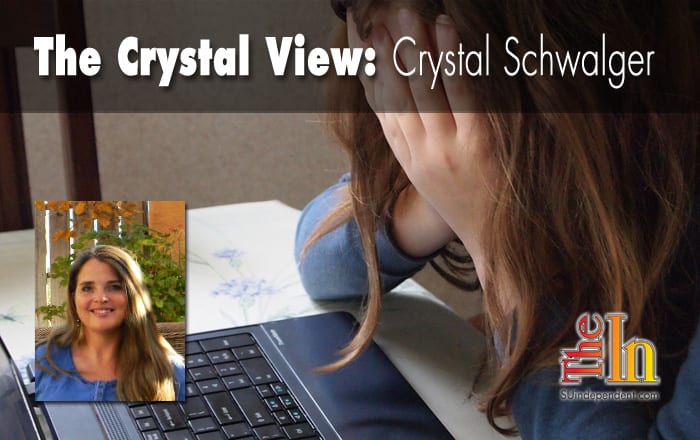
Written by Crystal Schwalger
Today my ninth grader came home from school feeling not only frustrated but also angry. She had worked very hard on an African geography project and was very proud of how it had turned out. She had done such an exceptional job that her teacher posted it on his “Wall of Fame” board as an example to others on how to do the assignment correctly. The only problem was that today someone snuck into the classroom, torn it down, and ripped it up. Naturally she was upset about why someone would do such a thing. The teacher had not caught the culprit but was sure that it must have been a girl.
My husband and I talked to our daughter about what had happened and calmed her down, explaining that whoever had done this was obviously jealous of how well she was doing and most likely also had low self-esteem. We also told her not to let something like this hold her back but rather to continue to do her best and not to worry about when other people try to bully her like that. Yes, I said “bully.” What happened to my daughter today may be mild, but it is a form of bullying nevertheless. As a parent, this infuriates me that someone would do something like that just to make my daughter mad or sad. While I am not surprise that this type of juvenile behavior still goes on in ninth grade, it still frustrates me that my daughter had been the target.
Unfortunately, bullying comes in all forms and is a widespread problem in middle and high schools all over the country. Bullying rarely starts as a full scale attack but instead starts slowly in small, intimidating ways. Left unchecked, this behavior often then escalates to even more menacing actions.
According to The National Bullying Prevention Center, “nearly 1 in 3 students (27.8 percent) report being bullied during the last school year.” Online bullying was even worse, and statistics show that 80 percent of teens admit that they were bullied online while using some sort of social media. NoBullying.com reports that around 37 percent of students say they are experiencing cyberbullying frequently, and almost 20 percent of those being bullied online admitted that they are experiencing extreme bullying every day.
Those statistics are staggering to me. Not only do kids have to worry about being bullied in person, but now thanks to technology, they get to experience it online too, even within the safety of their own homes. Don’t get me wrong, I’m not blaming technology for bullying. Unfortunately, it’s just another vehicle that bullies can use to make other people’s lives miserable. Obviously this is an ongoing problem and needs to be stopped.
Too often people blame the victim, asking why the person being bullied didn’t just tell someone or stand up to the bully? Unfortunately, I understand why it is so hard to do those things because I know how it feels to be bullied. I was a victim of bullying when I was in middle school. Two boys had decided to start calling me a name thinking it funny. For weeks, they called me names, and I never told anyone. Not my parents, my teacher, or even my siblings. I was intimidated, and I felt embarrassed, like it was my fault. I was also afraid that if I told on them, it would make them mad and things would get worse. I tried not to let it bother me, and most of the times I just ignored them. Eventually they stopped when they couldn’t get a rise out of me, but the emotional trauma I felt from it affected me for a long time. I know all too well how it feels to worry about going to school and wonder if you were going to be harassed again.
Unfortunately, not all victims of bullying are able to have the bullying stop or go away. As said earlier, sometimes the incidents escalate to the point where the victims either feel suicidal or may retaliate violently in some way. Many of the notorious school shootings are believed to have some connection to bullying.
The Center for Disease Control reports that students who experience bullying may be at increased risk for depression, anxiety, sleep difficulties, and poor school adjustment. They also say that victimizations coupled with depression could lead to suicide-related behaviors, a statistic that no parent ever wants to hear.
Fortunately today, almost all schools across the country have anti-bullying campaigns and awareness. They do play-acting scenarios, and they try to empower students to take actions when they see this type of behavior going on and to get involved. Statistics show that close to 60 percent of bullying stops when a peer intervenes on behalf of the student being bullied. Schools can help to facilitate this by creating an environment of respect and tolerance. They can also help by encouraging students to stand up for one another and recognizing and rewarding those that help.
As parents, we need to talk to our children. Really talk. Get to know them so that we can see when something is bothering them and help them know that they are not alone. Family support, as well as peer support, can play a huge part in helping to overcome the emotional trauma not only those victimized by bullying but also those who are doing the bullying. They both need love and attention, and social skills that they can use to make the world a place of light, not darkness.
Bullying is a nasty word, and can do unseen damage. In a world where there is too much hate, bitterness, and bullying going on, my wish as a mother is to help my children have the skills to recognize bullying in all its forms and stand against it. In one of Bob Marley’s songs, he says “light up the darkness.” I couldn’t agree more.




